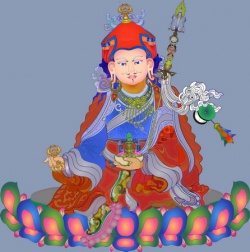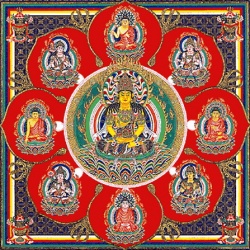Difference between revisions of "The Vehicles of Enlightenment"
(Created page with " <poem> Buddhism teached of various vehicles for escaping suffering and ignorance and transcending the Life & Death of the Threefold Realm. These vehi...") |
|||
| Line 1: | Line 1: | ||
| − | + | {{DisplayImages|386|1726}} | |
<poem> | <poem> | ||
[[Buddhism]] teached of various vehicles for escaping [[suffering]] and [[ignorance]] and transcending the [[Life]] & [[Death]] of the [[Threefold Realm]]. These vehicles are for [[people]] of varying degrees of inclination and capacity for the [[spiritual]] [[life]]: | [[Buddhism]] teached of various vehicles for escaping [[suffering]] and [[ignorance]] and transcending the [[Life]] & [[Death]] of the [[Threefold Realm]]. These vehicles are for [[people]] of varying degrees of inclination and capacity for the [[spiritual]] [[life]]: | ||
Revision as of 11:28, 21 March 2014
Buddhism teached of various vehicles for escaping suffering and ignorance and transcending the Life & Death of the Threefold Realm. These vehicles are for people of varying degrees of inclination and capacity for the spiritual life:
The first two vehicles are for those who who do not seek to escape the life of the threefold realm:
The Vehicle of Personality Development. This is for those comfortable with the material world with modest interest in or capacity for the spiritual life. The basic precepts of morality are taught to purify their desires and to guide them to avoid evil, do good works and develop good character.
The Vehicle of Heaven. This is for those of greater interest in and capacity for spirituality, but still clinging to the material world. The practice of worship and meditation is taught to help them attain serenity, mastery of desire, self-control and mental concentration (Samadhi).
The next two vehicles are those that wish to escape the the prison of the threefold realm and live the noble and selfless life. They are designed to destroy the illusion of ego-centrism, emotional distress (klesas), and the four currents (asravas) of ignorance, desire for sensory gratification, craving for selfish existence, and attachment to views or opinions. Often described in the Sutras as the ‘Two Vehicles’, they aspire to an ideal of an Arhat, one liberated forever from rebirth as a self in the threefold realm. Since these vehicles are only about one’s own spiritual awakening and liberation, they are called the ‘Small Vehicle’.
The Vehicle of the Spiritual Disciple (Sravaka). This is for those that wish to overcome suffering and seek release from the threefold realm. They are taught the Four Truths, mental concentration and spiritual insight, the 37 facets of spiritual awakening and the Nirvana of non-attachment.
The Vehicle of Spiritual Awakening to Causality and Conditions (Pratyekabuddha). This is for those of keener spiritual capacity who seek release from the threefold realm. They are taught the twelve-fold wheel of dependence of origination, mental concentration and spiritual insight, the 37 facets of spiritual awakening, and the spiritual nature of reality and selflessness.
The next vehicle is for those that wish to be free of the threefold realm but also remain engaged in it in order to help others become liberated. In being simultaneously for oneself and for others it is called the ‘Great Vehicle’. It is the cause of enlightenment.
The Vehicle of the Bodhisattva; It is for those who recognize that their spiritual life is inseparable from that of all other living beings. One makes a vow of compassion to aspire for the universal enlightenment of all. One cultivates all that above, plus generosity, compassion, and the six perfections. One worships, serves and does the work of the Buddha.
The final vehicle is the ultimate effect of enlightenment. Understanding the true purpose for the one's appearance in the world and serving as a font of enlightenment for all living beings.
The Vehicle of the Buddha; This is the One Vehicle that includes all vehicles.
The Great Calm-Observation says:
“From the beginning, the gradual method of Calm-Observation recognizes the True Spiritual Aspect of Reality1. The Aspect of Reality is difficult to understand. The gradual, sequential method makes it easier to practice.
First one takes refuge in the precepts of morality, rejecting falsehood and facing the truth. One calms the fire, the blood, and the sword2, and reaches the three good paths3.
Next one cultivates meditative concentration. One calms the scattering networks of desire, and reaches into the path that is meditation of the material and the immaterial realms.
Next one cultivates non-affliction. One calms all attachments to the threefold realm4 and reaches the path of nirvana5.
Next one cultivates mercy and compassion, calms the attachments to one's own personal realization and reaches the path of the Bodhisattvas6.
Finally, one cultivates the True Spiritual Aspect of Reality. One calms the inclinations to extremes, and reaches the path of that which is ever remaining7.
This begins being shallow and ends being deep, and is the Gradual and Sequential Aspect of Calm-Observation.”

